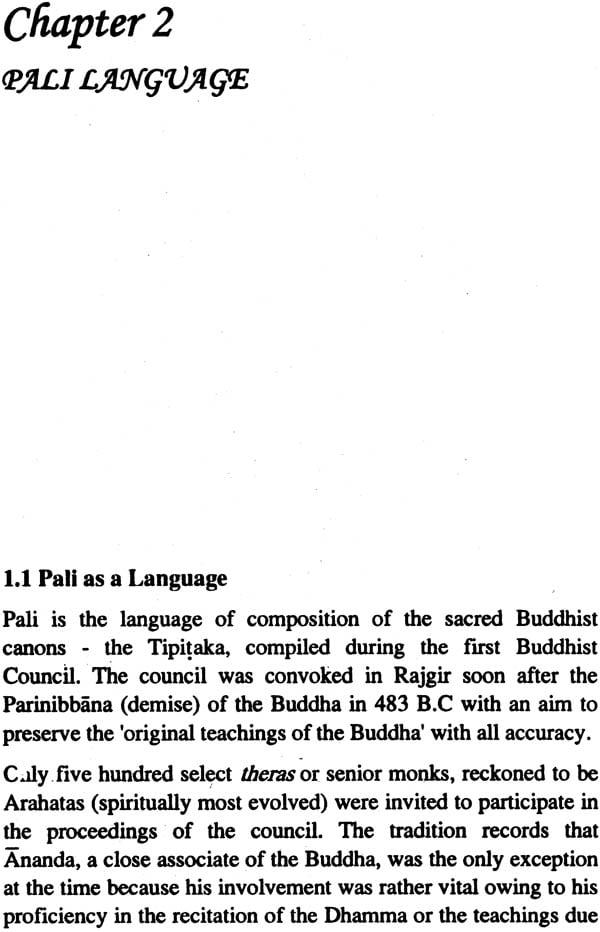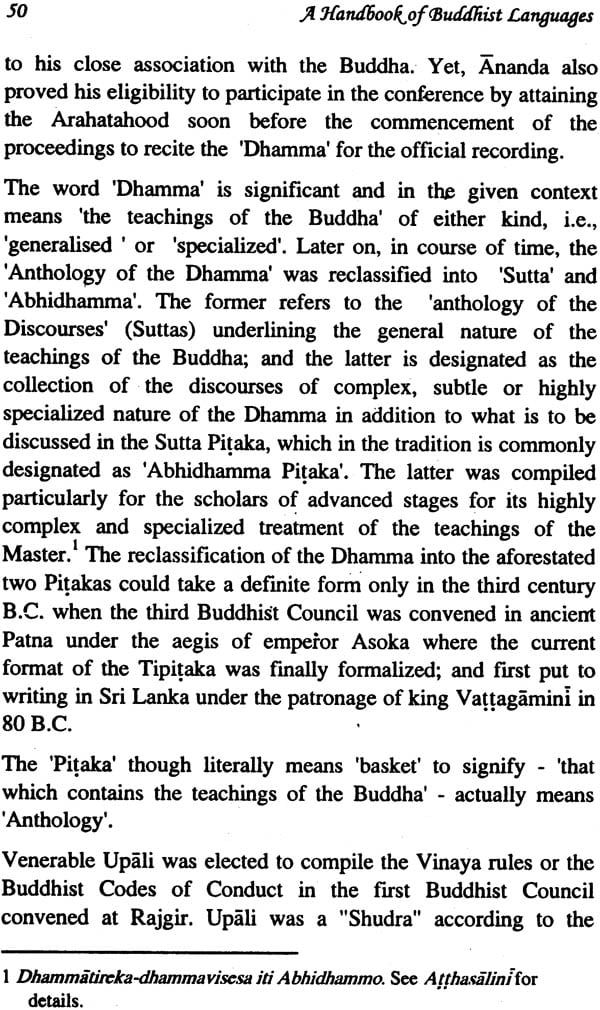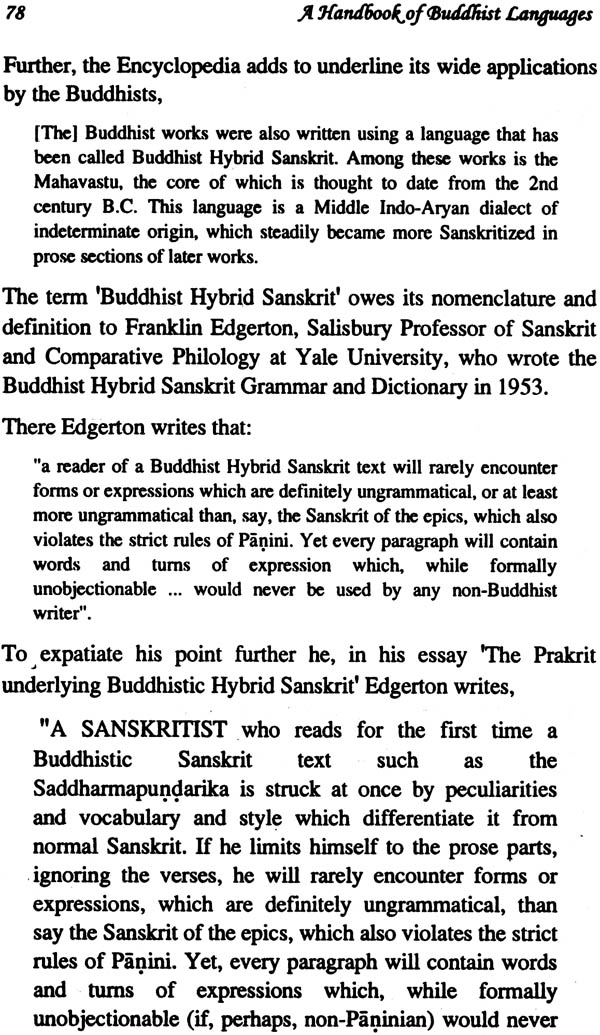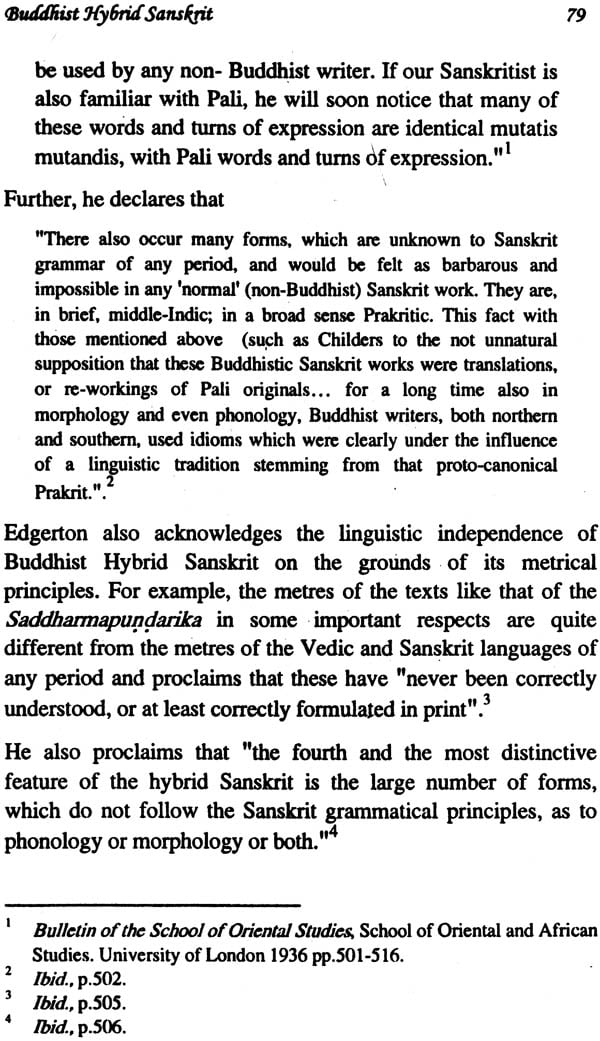
A Handbook of Buddhist Languages
Book Specification
| Item Code: | NAL805 |
| Author: | Dr. Chandra B. Varma |
| Publisher: | Buddhist World Press |
| Language: | English |
| Edition: | 2011 |
| ISBN: | 9789380852034 |
| Pages: | 104 (1 Map) |
| Cover: | Paperback |
| Other Details | 9.0 inch X 6.0 inch |
| Weight | 280 gm |
Book Description
“The original Buddhist teaching have been compiled in a language called Pali, a kind of “Prakrti” or the people’s language, which in turn was the lingua franca of a large part of the Indian sub-continent and thrived in juxtaposition with the Sacred Vedic Languages or perhaps, even prior to the composition of the Vedic texts. Needles to state that the people’s languages, Collectively called “Prakrti”, eventually evolved into most of the modern-day vernacular languages of our nation. Further, it would be preposterous to think that there existed no language across the subcontinent when the Vedic language was in use…”
“Sanskrit (literally the purified language) … culminated in the work of Panini about the year 300 B.C. … represents a polished from of an archaic tongue, which by Panini’s time was no longer a vernacular. … we may take the language of … the archaic dialect of the Upper Doab of which the Sanskrit became the polished language… It is thus a mistake to say that any modern Indian language is derived from Sanskrit.”
(Imperial Gazetteer of India, republished by Clarendon Press, Oxford: 1909 pp. 357-58.)
Dr Chandra B. Varma, D. Litt, has authored over a dozen books, chief on Buddhism and related subjects of academic interest. His noteworthy publications include A Concise Encyclopedia of Early Buddhist Philosophy, Buddhist Phenomenology, Methodology for Editing and Translating a Source Material on History of Science (2 vols), Dictionary of Abhidhammic Terms (with Foreword by George Cardona), Text and Translation of the Abidhammatthasangaha-Sarupa (Pali ms. No. 353 of Bibliotheque Nationale, Paris), Manual of Buddhism, Manual of Buddhist Literature and so on. Besides, over forty of his articles have been printed by Sahitya Akademi (Indian Academy of Letters). Future, two of his web-enable projects on the thematic interpretations of the Buddhist arts and paintings by way of over hundred ‘Illustrated Jataka and Other Stories of the Buddha’ have been published by Indira Gandhi National Centre for the A r t s , w h i c h c a n b e v i e w e d a t http://www.ignca.nic.in./Jatak.htm (in English); and its Hindi version, sponsored by Ministry of Culture and Information Technology, Government of India at http://tdil.mit.gov.in/Coil Net/IGNCA/Jatak.htm.
Dr Varma is currently Head of the Centre for Buddhist Studies at Central University of Hyderabad.
Academic Relevance of Buddhist Studies One may wonder, why Buddhism should be taught in academics! The question is undoubtedly pertinent. Yet, what seems to be more pertinent to question as to why the world’s top universities like Harvard and Oxford have accepted Buddhist Studies as an independent branch of learning; and treat it integral to their academic curricula. Why University of California at Berkeley runs more that forty course on Buddhism in Fall 2010. As a matter of fact, Professor Richard Gombrich, the Director of Buddhist Studies Centre at University of Oxford when visited University of Hyderabad on 12 February 2007 on invitation by the author as the Coordinator Buddhist Studies Programme of University of Hyderabad – emphatically asserted that the “same criterion must be applied to the introduction of the Buddhist Studies course to a university as is applied to any other discipline”.
In the context, it is not out of places to quote another great Buddhologist Alex Wayman, who observes,
Here, the word “virtually” used by Wayman is highly suggestive in as much as that it accentuates the fact that Buddhism in India, now, does not exist in its pure or original from as it has been fused with Brahmanism where Buddha is reckoned to be an avatar of Visnu – a belief which is unacceptable not only to a Tibetan, Chinese, Japanese, Sri Lankan, Burmese, Thai and all other orthodox Buddhists but also offensive to many; and discordant to very spirit of Indian secularism and Government’s academic or educational policies.
The original Buddhist teachings have been compiled in a language called Pali, a kind of “Prakrit” or the people’s language , which in turn was the lingua franca of a large part of the Indian sub-continent and thrived in juxtaposition with the Sacred Vedic Language or perhaps, even prior to the composition of the Vedic texts. Needless top state that the people’s languages, collectively called “Parkrit”, eventually evolved into most of the modern-day vernacular languages of our nation. Future, it would be preposterous to think that there existed no language across the subcontinent when the Vedic language was in use. On contrary, it is affirmed that the use of the Vedic language was the prerogative of a handful of people particularly belonging to the privileged priestly class for religious only, It is noteworthy that the Vedic language, which is often designated as the “Chands”, “Devavani” and “Girvana Vani” was seldom called “Sanskrti” by the traditional Vedic scholars because the word ‘Sanskrti’ or Samskrta”, which means “refined” and “purified” had to be designative of those languages which had to be Sanskritised or Samskarita (i.e., “refined”, “purified”, “cultured” and “standardized”) within the framework of the Paninian scale of grammar. The above view is further substantiated by the fact that language of the Veda is considered to be “perfect” owing to the belief that it was of divine origin; hence any attempt to refine or purify a divine language would become out of question for any orthodox, conservative and traditional Vedic scholars; or the dominant society that had upheld the Vedic ideals. Moreover, the composition of the Paninian Grammar is denfinitely post-Buddhistic as its composition cannot be dated prior to the Age of the Buddha as the history would tell us.
The above view has also been endorsed by the assertion made in the Imperial Gazetter of India – prepared under the “Authority of His Majesty’s Secretary of State for India in Council” first published in 1881 for official use of the government of India – avowedly affirms that
All the more, the Vedic language involves accents and intonations for impeccable religious chantings and recitation; and was thus hardly put to writing or encouraged for writing in the ancient age. Besides, the conservative outlook and priestly zeal to preserve the purity of the Vedic texts also blocked its accessibility to a common man and woman for sacred reasons. Thus, notwithstanding all the merits and ancient historicity the Vedic texts continued to be transmitted only orally from one generation to another down the ages. No wonder the scholars and Indologists like Professor Michael Witzel of Harvard University, who has, as of now , not been successful in tracing a single Vedic manuscript that could be conclusively dated prior to the fourteenth century A.D.
On the contrary, the archaelogists and historians have no disagreement in admitting that Barhmi script adopted by Asoka in the third century B.C. for inscribing the Pali-prakrit texts (depicted in his edicts all over the Magadhan empire and extending even beyond the India sub-continent to include parts of Greece and Syria as well as is clearly corroborated by Major Rock edict XIV of the Asokan empire, are as a matter of fact, still extant and readable today . These Pali-Prakrit inscriptions on the stone tables and metallic pillars are vocal not only to feel the heat of the Buddhist influence on the emperor, but also radiate the emperor’s faith in the triple gem of Buddhism, namely, the Buddha, the Dhamma, and the Sangha, which he so tenaciously sought to glorify. For example, the famous Bhabru inscription affirms not only his faith in the triple gem with rich referencing to the Pali canonical texts on the Vinaya …, Upatissa’s Questions, Rahulovada Sutta and so on but also declares his ardent zeal, rather avowedly, to enternalize the teaching of the Masyer through those inscriptions:
| Introduction | 1 | |
| Chapter 1: Profile of Buddhist Languages | ||
| 1.1 : | Buddhist Contribution to the Writing Systems of India and Asia | 13 |
| 1.2 : | Buddhist Role to the Growth of India Scripts | 16 |
| 1.3 : | Growth of North India Scripts | 16 |
| 1.4 : | Growth of Scripts in South India and Sri Lanka | 20 |
| 1.5 : | Tibetan, Chinese and Japanese Shittan | 21 |
| 2 : | Proflie of Brahmi-Derived-Scripts | 23 |
| 2.1 : | Scripts for writing Pali and Prakrti | 25 |
| 2.2 : | Model of Transcriptions for Pali in Roman Script Brahmi, Kharosthi, Singhalese, Burmese, Khmera, Siamese, Gupta, Siddham, Purva Licchavi, Uttara Licchavi, Conjunct of Vowels, Ranjana, Tibetan, Sarada and Devangari | 25 |
| 2.3 : | Pali Compositions in Various scripts | 42 |
| Chapter 2: Pali Language | ||
| 1.1 : | Pali as a language | 49 |
| 1.2 : | Traditional Buddhist view of the Trem 'Pali' | 56 |
| 1.3 : | Pali as the language of Tipitaka | 58 |
| 1.4 : | Linguistic Characteristics of Pali | 60 |
| Chapter 3: Prakrit Language | ||
| 1.1 : | The Prakrti Language | 62 |
| 1.2 : | Historicity of the Prakrti Language | 64 |
| 1.3 : | Prakrti Family of Languages | 70 |
| 1.4 : | Buddhist Compositions in Prakrti | 75 |
| 1.5 : | Niya and Gandhari Prakrti | 75 |
| Chapter 4: Buddhist Hybrid Sanskrit | ||
| 1.1 : | Buddhist Hybrid Sanskrti as a Language | 77 |
| 1.2 : | Historicity of Buddhist Hybrid Sanskrit | 81 |
| 2 : | Linguistic Profile of BHS | 85 |
| 2.1 : | Characteristics of the Language | 85 |
| 2.2 : | Linguistic Peculiarities of BHS | 86 |
| 2.3 : | Outlines of Buddhist Hybrid Sanskrti Literature | 87 |
| 2.4 : | Influence of Buddhist Hybrid Sanskrti on Classical Sanskrti | 91 |
| Bibligraphy | 93 | |
| Index | 99 |









